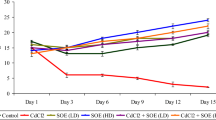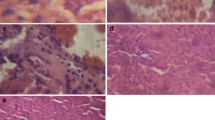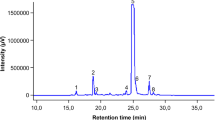Abstract
Rosa persica is a member of the Rosaceae family that has a wide range of pharmacological properties. In this study, the antioxidant and therapeutic potential of this plant was investigated on cadmium (Cd)-induced hepatotoxicity. Rosa persica extract (RPE) was prepared by a maceration method in hydroalcoholic solvent, and its antioxidant properties were determined. Then, 36 mice were divided to six groups and treated for 2 weeks as follows: control, Cd (3 mg/kg), RPE (50 mg/kg), and groups 4–6 received Cd (3 mg/kg) and 12.5, 25, and 50 mg/kg of RPE respectively. The total polyphenol, flavonoids contents, and total antioxidant capacity in RPE were measured 263.4 ± 7.2 mg rutin equivalent/g extract, 72.3 ± 2.3 mg quercetin equivalent/g extract, and 8.46 ± 0.27 μmol ferrous sulfate/g extract, respectively. The in vivo results showed that Cd elicited remarkable hepatic injury that was manifested by the significant increase in serum hepatic enzymes. In addition, Cd significantly increased the levels of lipid peroxidation (LPO) and tumor necrosis factor-alpha (TNF-α) and decreased total thiol molecules (TTM) and total antioxidant capacity (TAC) in hepatic tissue. However, RPE decreased serum hepatic enzyme levels and improved oxidative hepatic damage by lowering the LPO and TNF-α levels and raising TAC and TTM in in Cd-treated groups. Although the RPE increased the metallothionein (MT) protein content, there was no change in MT gene expression. The present study showed that the RPE due to having antioxidant properties might partially prevent hepatic oxidative damage by the improvement of oxidant/antioxidant balance in animals exposed to Cd.






Similar content being viewed by others
References
Abdeen A, Abou-Zaid OA, Abdel-Maksoud HA, Aboubakr M, Abdelkader A, Abdelnaby A, Abo-Ahmed AI, El-Mleeh A, Mostafa O, Abdel-Daim M, Aleya L (2019a) Cadmium overload modulates piroxicam-regulated oxidative damage and apoptotic pathways. Environ Sci Pollut Res Int 26(24):25167–25177
Abdeen A, Abdelkader A, Abdo M, Wareth G, Aboubakr M, Aleya L, Abdel-Daim M (2019b) Protective effect of cinnamon against acetaminophen-mediated cellular damage and apoptosis in renal tissue. Environ Sci Pollut Res Int 26(1):240–249
Amamou F, Nemmiche S, Kaouthar Meziane R, Didi A, Yazit SM, Chabane-Sari D (2015) Protective effect of olive oil and colocynth oil against cadmium-induced oxidative stress in the liver of Wistar rats. Food Chem Toxicol 78:177–184
Arroyo V, Flores K, Ortiz L, Gómez-Quiroz L, Gutiérrez-Ruiz M (2012) Liver and cadmium toxicity. J Drug Metab Toxicol S5:1–7
Begic A, Djuric A, Ninkovic M, Stevanovic I, Djurdjevic D, Pavlovic M, Jelic K, Pantelic A, Zebic G, Dejanovic B (2017) Disulfiram moderately restores impaired hepatic redox status of rats subchronically exposed to cadmium. J Enzyme Inhib Med Chem 32(1):478–489
Benzie IF, Strain JJ (1996) The ferric reducing ability of plasma (FRAP) as a measure of “antioxidant power”: the FRAP assay. Anal Biochem 239(1):70–76
Bhakuni GS, Bedi O, Bariwal J, Kumar P (2017) Hepatoprotective activity of morin and its semi-synthetic derivatives against alcohol induced hepatotoxicity in rats. Indian J Physiol Pharmacol 61(2):175–190
Bhosale VV, Banerjee D (2020) Scientific validation of herbal medicine. In: Sen S, Chakraborty R (eds) Herbal medicine in India. Springer, Singapore
Boskabady MH, Shafei MN, Saberi Z, Amini S (2011) Pharmacological effects of rosa damascena. Iran J Basic Med Sci 14(4):295–307
Cardiff RD, Miller CH, Munn RJ (2014, 2014) Manual hematoxylin and eosin staining of mouse tissue sections. Cold Spring Harb Protoc (6):pdb-rot073411
Chen L, Ma L, Bai Q, Zhu X, Zhang J, Wei Q, Li D, Gao C, Li J, Zhang Z, Liu C, He Z, Zeng X, Zhang A, Qu W, Zhuang Z, Chen W, Xiao Y (2014) Heavy metal-induced metallothionein expression is regulated by specific protein phosphatase 2A complexes. J Biol Chem 289(32):22413–22426
Chen X, Ren S, Zhu G, Wang Z, Wen X (2017) Emodin suppresses cadmium-induced osteoporosis by inhibiting osteoclast formation. Environ Toxicol Pharmacol 54:162–168
Contreras-Zentella ML, Hernández-Muñoz R (2016) Is liver enzyme release really associated with cell necrosis induced by oxidant stress? Oxidative Med Cell Longev 2016:1–12
Cuypers A, Plusquin M, Remans T, Jozefczak M, Keunen E, Gielen H, Opdenakker K, Nair AR, Munters E, Artois TJ, Nawrot T (2010) Cadmium stress: an oxidative challenge. Biometals 23(5):927–940
Dastan D, Karimi S, Larki-Harchegani A, Nili-Ahmadabadi A (2019) Protective effects of Allium hirtifolium Boiss extract on cadmium-induced renal failure in rats. Environ Sci Pollut Res Int 26:18886–18892
El-Boshy ME, Risha EF, Abdelhamid FM, Mubarak MS, Hadda TB (2015) Protective effects of selenium against cadmium induced hematological disturbances, immunosuppressive, oxidative stress and hepatorenal damage in rats. J Trace Elem Med Biol 29:104–110
Ghasemzadeh A, Ghasemzadeh N (2011) Flavonoids and phenolic acids: role and biochemical activity in plants and human. J Med Plant Res 5(31):6697–6703
Goorden SM, Buffart TE, Bakker A, Buijs MM (2013) Liver disorders in adults: ALT and AST. Ned Tijdschr Geneeskd 157(43):A6443
Gottlieb E, Vander Heiden MG, Thompson CB (2000) Bcl-xL prevents the initial decrease in mitochondrial membrane potential and subsequent reactive oxygen species production during tumor necrosis factor alpha-induced apoptosis. Mol Cell Biol 20(15):5680–5689
Gu X, Manautou JE (2012) Molecular mechanisms underlying chemical liver injury. Expert Rev Mol Med 14:e4–e4
Harchegani AL, Hemmati AA, Nili-Ahmadabadi A, Darabi B, Shabib S (2017) Cromolyn sodium attenuates paraquat-induced lung injury by modulation of proinflammatory cytokines. Drug Res 67(05):283–288
Hartwig A (2013) Cadmium and cancer, cadmium: from toxicity to essentiality. Springer, pp 491-507
Heshmati A, Karami-Momtaz J, Nili-Ahmadabadi A, Ghadimi S (2017) Dietary exposure to toxic and essential trace elements by consumption of wild and farmed carp (Cyprinus carpio) and Caspian kutum (Rutilus frisii kutum) in Iran. Chemosphere 173:207–215
Hu ML (1994) Measurement of protein thiol groups and glutathione in plasma. Methods Enzymol 233:380–385
Ige SF, Olaleye SB, Akhigbe RE, Akanbi TA, Oyekunle OA, Udoh UA (2012) Testicular toxicity and sperm quality following cadmium exposure in rats: ameliorative potentials of Allium cepa. J Hum Reprod Sci 5(1):37–42
Jassbi AR, Zamanizadejarib S, Tahara S (2003) Polyphenolic antioxidant constituents of Rosa persica. J Chem Soc Pak 4(25):323–327
Jihen el H, Imed M, Fatima H, Abdelhamid K (2009) Protective effects of selenium (Se) and zinc (Zn) on cadmium (Cd) toxicity in the liver of the rat: effects on the oxidative stress. Ecotoxicol Environ Saf 72(5):1559–1564
Kim J, Lee S, Park J, Yoo Y (2010) TNF-α-induced ROS production triggering apoptosis is directly linked to Romo1 and Bcl-XL. Cell Death Differ 17(9):1420–1434
Koczka N, Stefanovits-Bányai É, Ombódi A (2018) Total polyphenol content and antioxidant capacity of rosehips of some rosa species. Medicines 5(3):1–10
Ksouri R, Megdiche W, Falleh H, Trabelsi N, Boulaaba M, Smaoui A, Abdelly C (2008) Influence of biological, environmental and technical factors on phenolic content and antioxidant activities of Tunisian halophytes. C R Biol 331(11):865–873
Li Y, Yang H, Liu N, Luo J, Wang Q, Wang L (2015) Cadmium accumulation and metallothionein biosynthesis in cadmium-treated freshwater mussel Anodonta woodiana. PLoS One 10(2):e0117037
Li H, Fagerberg B, Sallsten G, Borné Y, Hedblad B, Engström G, Barregard L, Andersson EM (2019) Smoking-induced risk of future cardiovascular disease is partly mediated by cadmium in tobacco: Malmö Diet and Cancer Cohort Study. Environ Health 18(1):56
Liu Y-T, Lu B-N, Peng J-Y (2011) Hepatoprotective activity of the total flavonoids from Rosa laevigata Michx fruit in mice treated by paracetamol. Food Chem 125(2):719–725
Liu L, Tao R, Huang J, He X, Qu L, Jin Y, Zhang S, Fu Z (2015) Hepatic oxidative stress and inflammatory responses with cadmium exposure in male mice. Environ Toxicol Pharmacol 39(1):229–236
Mavi A, Terzi Z, Ozgen U, Yildirim A, Coskun M (2004) Antioxidant properties of some medicinal plants: Prangos ferulacea (Apiaceae), Sedum sempervivoides (Crassulaceae), Malva neglecta (Malvaceae), Cruciata taurica (Rubiaceae), Rosa pimpinellifolia (Rosaceae), Galium verum subsp. verum (Rubiaceae), Urtica dioica (Urticaceae). Biol Pharm Bull 27(5):702–705
Miled HB, Barka ZB, Hallegue D, Lahbib K, Ladjimi M, Tlili M, Sakly M, Rhouma KB, Ksouri R, Tebourbi O (2017) Hepatoprotective activity of Rhus oxyacantha root cortex extract against DDT-induced liver injury in rats. Biomed Pharmacother 90:203–215
Mohebitabar S, Shirazi M, Bioos S, Rahimi R, Malekshahi F, Nejatbakhsh F (2017) Therapeutic efficacy of rose oil: a comprehensive review of clinical evidence. Avicenna J Phytomed 7(3):206–213
Moradkhani S, Kobarfard F, Ayatollahi SA (2014) Phytochemical investigations on chemical constituents of Achillea tenuifolia Lam. Iran J Pharm Res 13(3):1049–1054
Myhrstad MC, Carlsen H, Nordstrom O, Blomhoff R, Moskaug JO (2002) Flavonoids increase the intracellular glutathione level by transactivation of the gamma-glutamylcysteine synthetase catalytical subunit promoter. Free Radic Biol Med 32(5):386–393
Ohkawa H, Ohishi N, Yagi K (1979) Assay for lipid peroxides in animal tissues by thiobarbituric acid reaction. Anal Biochem 95(2):351–358
Okoye CN, MacDonald-Jay N, Kamunde C (2019) Effects of bioenergetics, temperature and cadmium on liver mitochondria reactive oxygen species production and consumption. Aquat Toxicol 214:105264
Ordonez AAL, Gomez JD, Vattuone MA, lsla MI (2006): Antioxidant activities of Sechium edule (Jacq.) Swartz extracts. Food Chem 97(3), 452-458
Pathak S, Thakur M (2019): Plants as natural antioxidants-a review. International Journal of Management, Law & Science Studies 3(7)
Rani A, Kumar A, Lal A, Pant M (2014) Cellular mechanisms of cadmium-induced toxicity: a review. Int J Environ Health Res 24(4):378–399
Rezvani-Kamran A, Salehi I, Shahidi S, Zarei M, Moradkhani S, Komaki A (2017) Effects of the hydroalcoholic extract of Rosa damascena on learning and memory in male rats consuming a high-fat diet. Pharm Biol 55(1):2065–2073
Sadraei H, Asghari G, Jalali F (2016) Assessment of hydroalcoholic and hexane extracts of Rosa persica Mich. flower on rat ileum spasm. Res Pharm Sci 11(2):160–167
Sandbichler A, Höckner M (2016) Cadmium protection strategies—a hidden trade-off? Int J Mol Sci 17(1):1–22
Sanjeev S, Bidanchi RM, Murthy MK, Gurusubramanian G, Roy VK (2019) Influence of ferulic acid consumption in ameliorating the cadmium-induced liver and renal oxidative damage in rats. Environ Sci Pollut Res Int 26(20):20631–20653
Tao X, Sun X, Xu L, Yin L, Han X, Qi Y, Xu Y, Zhao Y, Wang C, Peng J (2016) Total flavonoids from Rosa laevigata Michx fruit ameliorates hepatic ischemia/reperfusion injury through inhibition of oxidative stress and inflammation in rats. Nutrients 8(7):418
Tursun X, Zhao Y, Alat Z, Xin X, Tursun A, Abdulla R, AkberAisa H (2016) Anti-inflammatory effect of Rosa rugosa flower extract in lipopolysaccharide-stimulated RAW264.7 macrophages. Biomol Ther 24(2):184–190
Vicente-Sanchez C, Egido J, Sanchez-Gonzalez PD, Perez-Barriocanal F, Lopez-Novoa JM, Morales AI (2008) Effect of the flavonoid quercetin on cadmium-induced hepatotoxicity. Food Chem Toxicol 46(6):2279–2287
Wang Y, Fang J, Leonard SS, Rao KM (2004) Cadmium inhibits the electron transfer chain and induces reactive oxygen species. Free Radic Biol Med 36(11):1434–1443
Watjen W, Beyersmann D (2004) Cadmium-induced apoptosis in C6 glioma cells: influence of oxidative stress. Biometals 17(1):65–78
Weng CJ, Chen MJ, Yeh CT, Yen GC (2011) Hepatoprotection of quercetin against oxidative stress by induction of metallothionein expression through activating MAPK and PI3K pathways and enhancing Nrf2 DNA-binding activity. New Biotechnol 28(6):767–777
Wong KL, Klaassen CD (1981) Relationship between liver and kidney levels of glutathione and metallothionein in rats. Toxicology 19(1):39–47
Yang S-H, Yu L-H, Li L, Guo Y, Zhang Y, Long M, Li P, He J-B (2018) Protective mechanism of sulforaphane on cadmium-induced sertoli cell injury in mice testis via nrf2/are signaling pathway. Molecules 23(7):1774
Zhang S, Lu B, Han X, Xu L, Qi Y, Yin L, Xu Y, Zhao Y, Liu K, Peng J (2013) Protection of the flavonoid fraction from Rosa laevigata Michx fruit against carbon tetrachloride-induced acute liver injury in mice. Food Chem Toxicol 55:60–69
Zou H, Wang T, Yuan J, Sun J, Yuan Y, Gu J, Liu X, Bian J, Liu Z (2019) Cadmium-induced cytotoxicity in mouse liver cells is associated with the disruption of autophagic flux via inhibiting the fusion of autophagosomes and lysosomes. Toxicol Lett 321:32–43
Funding
The financial support for conducting the present study was provided by the Vice-chancellor of Research and Technology, Hamadan University of Medical Sciences, Hamadan, I.R. Iran (Grant No. 9412187265).
Author information
Authors and Affiliations
Corresponding author
Ethics declarations
The study protocol was approved by HUMS Ethics Committee with the ethical number, IR.UMSHA.REC.1394.510, in accordance with the guideline of the Research Ethics Committee of the Ministry of Health and Medical Education, Iran (adopted on April 17, 2006), based on the Helsinki Protocol.
Conflict of interest
The authors declare that they have no conflicts of interest.
Additional information
Responsible Editor: Mohamed M. Abdel-Daim
Publisher’s note
Springer Nature remains neutral with regard to jurisdictional claims in published maps and institutional affiliations.
Rights and permissions
About this article
Cite this article
Moradkhani, S., Rezaei-Dehghanzadeh, T. & Nili-Ahmadabadi, A. Rosa persica hydroalcoholic extract improves cadmium-hepatotoxicity by modulating oxidative damage and tumor necrosis factor-alpha status. Environ Sci Pollut Res 27, 31259–31268 (2020). https://doi.org/10.1007/s11356-020-09450-4
Received:
Accepted:
Published:
Issue Date:
DOI: https://doi.org/10.1007/s11356-020-09450-4




